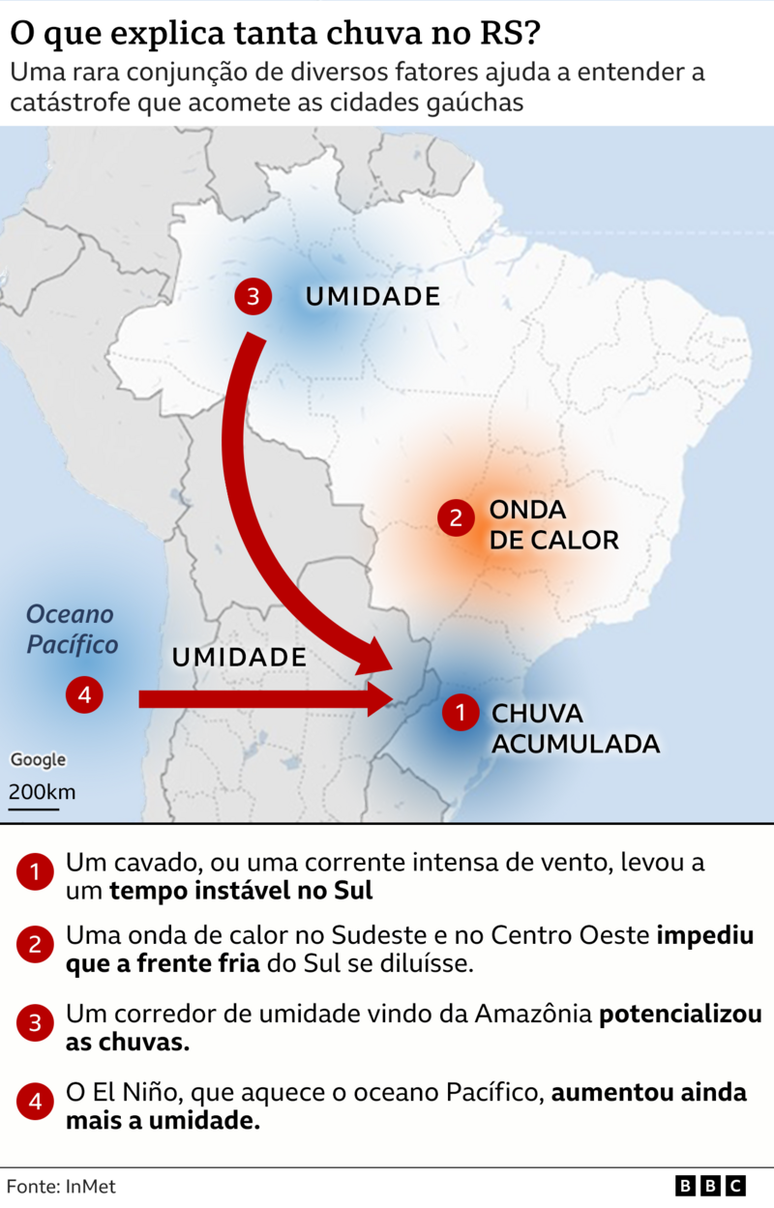The HAARP project is often cited by conspiracists as responsible for climate disasters, but the reality is that it has no ability to influence the climate.
Flooding in Rio Grande do Sul has reached a scale never seen before, affecting 388 of the state’s 497 municipalities.
Experts interviewed by BBC News Brasil point out that the cause of the problem is complex and has its roots in the combination of three main factors: an intense wind current, a humid corridor coming from the Amazon and a heat wave in the central region of the country.
But, even if atmospheric science is able to explain the environmental catastrophe, conspiracy theories are strengthening at the same time.
One, in particular, rose to prominence in Google searches last week and was among the most discussed topics on X, formerly Twitter.
He points out that Haarp, a North American scientific project that aims to study the physical phenomena that occur in the upper layers of the Earth’s atmosphere, would be the cause of the unusual rainfall in the state of Rio Grande do Sul.
The conspiracy theory claims that the episode was caused by “large power groups” with the aim of arousing fear, confusion and indignation and, based on the vulnerability caused, to assert their interests.
Haarp has also been the target of conspiracy theories in the past that claimed catastrophes such as the 2010 Haiti earthquake and the 2023 earthquake in Syria and Turkey were caused by the project’s antennas.
Conspiracists claim that a snowstorm in the US state of Iowa in January 2024 also influenced the country’s elections.
Such claims lack scientific evidence.
According to scientists consulted by BBC News Brasil, the impact and range of the antennas used in the project are limited, they operate in a specific area of the Earth’s layer and do not have the power to cause major changes, neither in temperature nor in temperature. , radiation levels or cause environmental catastrophes.
What is Haarp and why it cannot cause environmental disasters
The HAARP project focuses in particular on the ionosphere, the layer of the Earth’s atmosphere located between 80 and 640 km above the Earth’s surface.
This region serves as a boundary between the lower atmosphere, where we live, and outer space.
“There is no possibility that any climatic event will be triggered in such a high atmospheric layer, since clouds and air currents form in the troposphere, or at most in the stratosphere, which are the lowest layers, up to about 20 km of altitude”, explains Thiago Rangel, professor of Atmospheric Physics in the Postgraduate Program in Environmental Technologies of the UFMS (Federal University of Mato Grosso do Sul).
“HAARP antennas have no influence on meteorological phenomena, neither on a micro nor on a macro scale,” adds the expert.
Previously operated by the US Air Force and Navy, HAARP began being coordinated by the University of Alaska in 2014.
According to the program’s official website, the project aims to understand how radio wave transmissions interact with free electrons and ions in the ionosphere, knowledge used to improve communication systems such as Wi-Fi, mobile Internet for cell phones and mobile-based applications. on localization.
“Since it is a project that emits waves in the ionosphere, we try to create this connection, very remote, so that it is possible to influence the climate on a large scale”, evaluates Enio Pereira de Souza, professor of the Academic Unit of Science of ‘Atmosphere at the UFCG (Federal University District of Campina Grande).
“And that’s exactly how conspiracy theories are built: by putting together widespread elements and trying to make sense of them,” he adds.
Located in Alaska, the research base consists of high-power, high-frequency transmitting antennas called IRIs (an acronym in English for Ionospheric research instrument, or ionospheric research instrument).
Transmitters are used to send signals to the ionosphere, temporarily exciting a specific area to observe the behavior of this layer of the atmosphere and its interaction with radio waves.
HAARP management says the studies are essential to improving communications and surveillance systems for civilian and defense purposes.
In addition to the transmitter, HAARP also has a variety of sophisticated scientific instruments capable of observing and analyzing the physical processes that occur in the ionosphere when excited by IRI.
Thanks to these tools, conspiracy theories claim that Haarp would be able to control tectonic plates, atmospheric temperature and even the level of radiation that passes through the ozone layer.
With such control, the project would be able, according to these theories, to cause natural disasters, be a weapon of mass destruction and even be used for mind control thanks to its ability to emit high frequency waves.
According to Rangel, all this is not possible using Haarp antennas, which have a limited action, emitting waves only in the ionosphere layer and not interfering in the areas mentioned by the conspiracists.
The project’s official information explains that Haarp is basically a large radio transmitter.
“Radio waves interact with electric charges and currents and do not interact significantly with the troposphere. Radio waves in the frequency bands transmitted by Haarp are not absorbed in either the troposphere or the stratosphere, the two levels of the atmosphere that produce climate of the Earth. Since there is no interaction, there is no way to control the climate,” the project website reads.
“Furthermore, if ionospheric storms caused by the Sun itself don’t affect surface climate, there’s no chance that Haarp could either.”
On social media, profiles define the climate tragedy in Rio Grande do Sul as a “planned disaster” and highlight, among other alleged evidence, an anomalous cloud pattern.

Souza characterizes images seen in the sky as stratocumulus clouds, which are clouds that combine the characteristics of stratified clouds (low, horizontal, uniform clouds) and cumulus clouds (white, fluffy clouds commonly associated with mild weather).
These clouds are common and can indicate different weather conditions, from gray weather to thunderstorms, depending on altitude and temperature.
“Even today, in Campina Grande, the sky was similar”, comments the UFCG professor.
The reason for the floods in Rio Grande do Sul
Meteorologists interviewed by BBC News Brasil explain that the intense rainfall recorded in Rio Grande do Sul in recent days is the result of a combination of three main factors:
“This warm air mass over the central area of the country has blocked the cold front located in the southern region, preventing it from advancing and spreading towards other locations. The combination of these factors causes this instability to remain over the state, causing heavy rain and continues”, explains Dayse Moraes, meteorologist at Inmet.

In addition to this, the period between the end of April and the beginning of May 2024 is still influenced by the El Niño phenomenon, responsible for the warming of the waters of the Pacific Ocean, contributing to the creation of zones of instability in the State.
“This warming of the ocean generates a region of high pressure over the center of Brazil (South-East and Central-West), which inhibits the formation of clouds and rain and, in the most intense cases, causes episodes of extreme heat”, explains the Professor Thiago Rangel.
In the regions he mentioned, temperatures this autumn are about 5°C above average.
“At the same time, a current of warm, moist air coming from the Amazon, known as the ‘South Atlantic Convergence Zone (SCAS’) and popularly called ‘flying rivers of moisture’, encounters cold fronts coming from the south of the continent This causes the rapid rise of warm, moist air towards the upper layers of the atmosphere, triggering intense precipitation.”
“Due to the atmospheric blockage over the center of the country, the cold front cannot advance and remains stationary in the southern region of Brazil, forming what is called an occluded front. This combination favors high intensity rainfall, lasting for more than two days,” he adds.
This combination of several factors at once is considered rare by experts.
“What makes a very intense event is what we call a perfect storm. Separately, these events caused normal rainfall. When they occur in combination, the volume is very large. And another important aspect is the way cities affected are prepared to face it,” says Enio Pereira de Souza.
Source: Terra
Rose James is a Gossipify movie and series reviewer known for her in-depth analysis and unique perspective on the latest releases. With a background in film studies, she provides engaging and informative reviews, and keeps readers up to date with industry trends and emerging talents.






